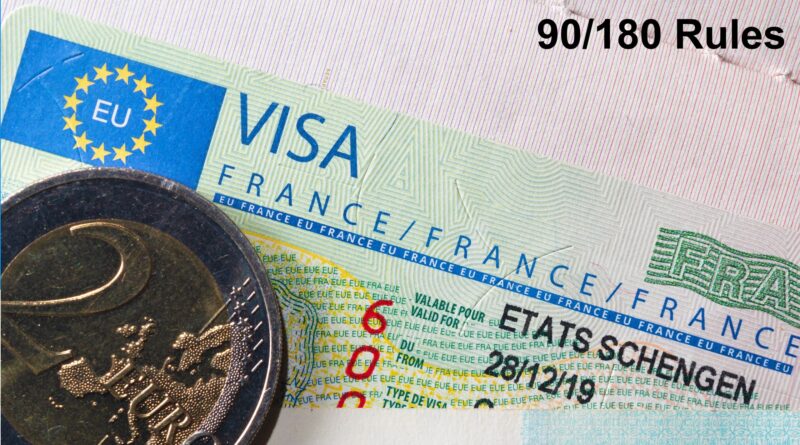The 90/180 Schengen Visa Rule: Schengen Visa Days Calculator
Understanding the 90/180 Schengen Visa Rule: Schengen Visa Days Calculator
Introduction: Mastering Europe’s Most Important Travel Rule
The 90/180 rule is arguably the most crucial regulation governing travel within the Schengen Area, yet it remains one of the most misunderstood aspects of European travel. Whether you’re planning a European vacation, considering digital nomad life across multiple countries, or thinking about extended stays in Europe, understanding this rule is essential to avoid overstays, fines, and potential entry bans.
This comprehensive guide will demystify the 90/180 Schengen rule, provide practical calculation methods, share real-world examples, and offer strategies for maximizing your time in Europe while staying fully compliant with immigration regulations.
What is the 90/180 Schengen Rule?
The Basic Principle
The 90/180 rule, officially known as the “short-stay” regulation, allows non-EU citizens to spend a maximum of 90 days within any 180-day period in the Schengen Area without requiring a long-stay visa or residence permit. This rule applies to all 29 Schengen countries collectively, not individually.
The key elements of this rule are:
90 Days Maximum: You can stay up to 90 days in total across all Schengen countries
180-Day Rolling Period: This period is calculated backward from any given day, not forward from your first entry
Collective Area: The limit applies to the entire Schengen Area as a single destination
No Reset Mechanism: Leaving and re-entering doesn’t reset the counter
Legal Foundation
The 90/180 rule is codified in the EU Visa Code (Regulation 810/2009) and applies to:
- Citizens of visa-exempt countries traveling without a Schengen visa
- Holders of short-stay Schengen visas (Type C visas)
- Anyone entering the Schengen Area for tourism, business, or short-term purposes
The rule does not apply to:
- EU/EEA citizens and their family members
- Holders of long-stay visas (Type D visas)
- Residence permit holders
- Certain diplomatic passport holders
Who Must Follow the 90/180 Rule?
Visa-Exempt Travelers
Citizens from approximately 60 countries can enter the Schengen Area without a visa for short stays. These travelers must still comply with the 90/180 rule. Major visa-exempt countries include:
North America: United States, Canada
Oceania: Australia, New Zealand
Asia: Japan, South Korea, Singapore, Hong Kong, Taiwan, Malaysia
Latin America: Chile, Argentina, Brazil, Mexico, Uruguay
Others: Israel, South Africa, Serbia, Montenegro
Schengen Visa Holders
Travelers with short-stay Schengen visas (Type C) must also follow the 90/180 rule. Even if your visa is valid for multiple years, you cannot exceed 90 days within any 180-day period.
Special Cases and Exceptions
Long-Stay Visa Holders: Type D visa holders can stay longer than 90 days but must comply with their specific visa conditions.
Residence Permit Holders: Those with valid residence permits from any Schengen country are exempt from the 90/180 rule.
Bilateral Agreements: Some countries have special bilateral agreements that may allow longer stays in specific Schengen countries, but these are rare and country-specific.
Transit Passengers: Airport transit doesn’t count toward the 90-day limit unless you enter the Schengen territory.
How to Calculate the 90/180 Rule
Understanding the Rolling 180-Day Period
The most crucial aspect of the 90/180 rule is understanding that the 180-day period is “rolling” or “moving.” This means:
Backward Calculation: From any given day, you look back 180 days to determine your allowable stay
No Fixed Start Date: The period doesn’t begin when you first enter Schengen
Continuous Monitoring: Every day requires checking the previous 180 days
Step-by-Step Calculation Method
Step 1: Choose your reference date (today or planned travel date)
Step 2: Count back 180 days from that date
Step 3: Add up all days spent in the Schengen Area during that 180-day period
Step 4: Subtract from 90 to determine remaining allowable days
Practical Example
Let’s say today is August 1, 2025:
- Look back to February 1, 2025 (180 days ago)
- Count all days spent in Schengen between February 1 and August 1
- If you spent 30 days during this period, you have 60 days remaining
- If you spent 90 days during this period, you cannot enter Schengen today
What Days Count?
Arrival Day: The day you enter any Schengen country counts as day 1
Departure Day: The day you leave the Schengen Area also counts
Transit Days: If you leave and re-enter on the same day (rare), it counts as one day
Partial Days: Any part of a day spent in Schengen counts as a full day
Common Misconceptions and Mistakes
Myth 1: “The Clock Resets When I Leave”
The Reality: Leaving the Schengen Area does not reset your 90-day allowance. The days you previously spent continue to count within the rolling 180-day period.
Example: If you spent 60 days in Europe in January-February, then left for Asia for two months, those 60 days still count when calculating your allowance in May.
Myth 2: “Each Country Has Its Own 90-Day Limit”
The Reality: The 90-day limit applies to the entire Schengen Area collectively, not to individual countries.
Example: If you spend 45 days in Spain and 45 days in France, you’ve used your full 90-day allowance across the Schengen Area.
Myth 3: “I Can Stay 90 Days Per Calendar Year”
The Reality: The rule is based on a rolling 180-day period, not calendar years.
Example: You could potentially visit twice per calendar year if properly planned, but each visit must comply with the rolling 180-day calculation.
Myth 4: “Tourist Visas Allow Longer Stays”
The Reality: Short-stay tourist visas are still subject to the 90/180 rule, regardless of the visa’s validity period.
Example: A multiple-entry Schengen visa valid for two years still limits you to 90 days within any 180-day period.
Myth 5: “Going to Non-Schengen EU Countries Resets the Clock”
The Reality: Visiting EU countries outside Schengen (like Romania, Bulgaria, or Croatia before 2023) doesn’t reset the Schengen clock, though time spent there doesn’t count toward the limit.
Practical Calculation Tools and Methods
Manual Calculation Methods
Calendar Method: Use a physical or digital calendar to mark all Schengen days and count backward 180 days from any reference date.
Spreadsheet Tracking: Create a simple spreadsheet with dates and cumulative day counts for precise tracking.
Paper Log: Maintain a written log of all entries and exits with running totals.
Digital Calculation Tools
Official EU Calculator: The European Commission provides online calculators for determining compliance with the 90/180 rule.
Mobile Apps: Several smartphone apps can track your Schengen days automatically:
- Schengen Calculator
- 90/180 Rule Calculator
- EU Visa Calculator
Travel Planning Software: Some travel planning platforms include Schengen compliance features.
Professional Services
Immigration Lawyers: For complex situations or business travelers with frequent trips
Travel Agents: Specialized agents can help plan compliant itineraries
Corporate Travel Services: For companies managing employee travel across Europe
Real-World Examples and Case Studies
Example 1: The Classic Tourist Mistake
Situation: Sarah, an American tourist, spent 85 days touring Europe from March 1 to May 24, 2025. She returned home and wants to visit again in August for a wedding.
Problem: When calculating from August 15 (proposed return date), looking back 180 days includes her entire March-May trip. She’s already used 85 of her 90 allowed days.
Solution: Sarah can only stay 5 more days in August, or she must wait until her original days “roll off” the 180-day window.
Example 2: The Digital Nomad Dilemma
Situation: Marcus, a Canadian freelancer, wants to spend 6 months working remotely across Europe, splitting time between Portugal, Spain, and France.
Problem: Even with perfect planning, he cannot legally stay 6 consecutive months in Schengen territory as a tourist.
Solution: Marcus needs to either limit his stay to 90 days, leave for at least 90 days before returning, or obtain a long-stay visa/residence permit.
Example 3: The Business Traveler’s Complex Schedule
Situation: Kenji, a Japanese business consultant, makes monthly 10-day trips to Germany throughout 2025.
Calculation:
- 12 trips × 10 days = 120 days total
- This exceeds the 90-day limit within any 180-day period
Solution: Kenji must either reduce trip frequency, shorten some trips, or obtain a business visa that allows longer stays.
Example 4: The Successful Long-Term Strategy
Situation: Maria, a Brazilian retiree, wants to spend significant time in Europe annually.
Strategy:
- January-March: 89 days in Europe
- April-June: Outside Europe
- July-September: 89 days in Europe
- October-December: Outside Europe
Result: By carefully timing her stays and ensuring adequate time outside Schengen, Maria can spend up to 178 days per year in Europe while remaining compliant.
Strategies for Maximizing Your European Time
The Split-Year Approach
Divide your year between Schengen and non-Schengen destinations to maximize European time while staying compliant.
High-Season Strategy: Spend summers (April-September) in Europe and winters elsewhere.
Shoulder Season Optimization: Visit during spring and fall for better weather and fewer crowds while maintaining compliance.
Festival and Event Planning: Time your visits around specific events while ensuring compliance.
Geographic Diversification
Combine Schengen visits with time in non-Schengen European countries and neighboring regions.
Eastern Europe: Spend time in Romania, Bulgaria, Serbia, or North Macedonia.
UK and Ireland: Visit the British Isles, which have separate visa regimes.
Mediterranean Alternatives: Consider Turkey, Cyprus, or North African countries.
Scandinavia Plus: Combine Schengen Nordic countries with non-Schengen destinations.
Visa Strategy Options
For those needing longer stays, consider alternative visa options:
Long-Stay Visas: National visas (Type D) for specific purposes like work, study, or family reunification.
Working Holiday Visas: Available for young people from certain countries.
Student Visas: For educational programs lasting longer than 90 days.
Investment Visas: Golden visa programs in countries like Portugal, Spain, or Greece.
Freelancer Visas: Some countries offer special visas for digital nomads and freelancers.
Consequences of Overstaying
Administrative Penalties
Fines: Overstay fines range from €500 to €3,000 depending on the country and duration of overstay.
Administrative Detention: Serious overstays may result in detention during deportation proceedings.
Deportation: Forced removal from the Schengen Area at your own expense.
Entry Bans
Duration: Entry bans typically range from 1 to 5 years, depending on the severity of the overstay.
Scope: Bans apply to the entire Schengen Area, not just the country where the overstay occurred.
Appeal Process: Limited options for appealing entry bans, usually requiring legal representation.
Long-Term Consequences
Future Visa Applications: Overstays make future visa applications more difficult and may result in automatic rejections.
Immigration Records: Overstays remain on permanent immigration records and may affect applications for residence permits or citizenship.
Travel Insurance: Some travel insurance policies may be invalidated by overstays.
Employment Implications: Overstays may affect background checks for international employment.
Special Situations and Exceptions
Medical Emergencies
Hospital Stays: Medical emergencies that prevent departure may be considered valid reasons for overstay, but require proper documentation.
Documentation Required: Medical certificates, hospital records, and proof of inability to travel.
Official Approval: Some countries require official approval for medical overstays.
Force Majeure Events
Natural Disasters: Events like volcanic eruptions, earthquakes, or severe weather may excuse overstays.
Political Unrest: Situations in your home country that prevent return may be considered.
Pandemic Restrictions: COVID-19 travel restrictions created many force majeure situations.
Family Emergencies
Serious Illness: Family medical emergencies may excuse short overstays with proper documentation.
Funerals: Attending family funerals may be considered humanitarian grounds for overstay.
Legal Requirements: Court proceedings or legal obligations may excuse overstays.
Documentation and Proof
Keep Records: Always maintain detailed records of all circumstances leading to overstay.
Official Documentation: Obtain official documents supporting your reason for overstay.
Legal Assistance: Consider consulting with immigration lawyers for serious overstay situations.
Country-Specific Variations and Enforcement
Enforcement Differences
While the 90/180 rule is uniform across the Schengen Area, enforcement can vary:
Border Control Intensity: Some countries conduct more thorough checks than others.
Technology Usage: Advanced countries use automated systems to track stays more accurately.
Penalty Variations: Fines and consequences can differ significantly between countries.
High-Enforcement Countries
Germany: Known for strict enforcement and detailed record-keeping.
Netherlands: Uses advanced technology and maintains comprehensive databases.
France: Strict enforcement, particularly at major airports and border crossings.
Switzerland: Non-EU member with particularly rigorous border controls.
Varying Approaches
Southern Europe: Some countries may be more lenient with minor overstays, particularly during peak tourist seasons.
Nordic Countries: Generally strict enforcement but may be more understanding of genuine emergencies.
Eastern Europe: Newer Schengen members may have varying levels of enforcement sophistication.
Future Changes and Developments
ETIAS Implementation
The European Travel Information and Authorization System (ETIAS), expected to launch in 2024-2025, will impact the 90/180 rule:
Pre-Authorization Required: Visa-exempt travelers must obtain ETIAS authorization before travel.
Enhanced Tracking: Better tracking of entries and exits will improve enforcement of the 90/180 rule.
Automated Calculations: The system may provide real-time compliance checking for travelers.
Entry/Exit System (EES)
The automated Entry/Exit System will replace passport stamping:
Digital Records: All entries and exits will be recorded digitally.
Real-Time Monitoring: Immediate calculation of remaining days for each traveler.
Improved Enforcement: Automatic flags for overstays and violations.
Potential Rule Changes
Brexit Impact: The UK’s departure may influence future Schengen policies.
Digital Nomad Visas: Some countries are developing special visas for remote workers that may complement the 90/180 rule.
Bilateral Agreements: New agreements between the EU and third countries may create exceptions or modifications to the rule.
Tips for Different Types of Travelers
Tourists and Leisure Travelers
Plan Ahead: Calculate your allowable days before booking expensive flights and accommodations.
Travel Insurance: Ensure your policy covers potential overstay situations and emergency extensions.
Documentation: Keep detailed records of all entries and exits.
Flexibility: Build flexibility into your travel plans to accommodate unexpected delays.
Business Travelers
Company Policies: Ensure your employer understands the 90/180 rule and plans business travel accordingly.
Visa Options: Consider business visas for frequent or extended business travel.
Record Keeping: Maintain meticulous records for both immigration and tax purposes.
Professional Advice: Consult with immigration professionals for complex business travel patterns.
Digital Nomads and Remote Workers
Legal Compliance: Understand that tourist status doesn’t permit work, even remotely.
Visa Alternatives: Research digital nomad visas and freelancer permits offered by various countries.
Geographic Strategy: Plan itineraries that include significant time outside the Schengen Area.
Professional Networks: Connect with other nomads who have successfully navigated these regulations.
Students and Researchers
Study Visas: Programs longer than 90 days require appropriate student visas.
Research Permits: Academic research may qualify for special visa categories.
Summer Programs: Short-term study programs must comply with the 90/180 rule.
University Support: Leverage institutional support for visa applications and compliance.
Retirees and Long-Term Visitors
Residence Options: Consider residence permit options for countries of interest.
Healthcare Planning: Ensure healthcare coverage extends to your planned stay duration.
Financial Requirements: Understand financial proof requirements for extended stays.
Integration Programs: Some countries offer programs to help long-term visitors integrate.
Technology Tools and Resources
Official Resources
European Commission Website: Provides official guidance and calculation tools.
National Immigration Websites: Each Schengen country maintains detailed information on their immigration website.
Embassy Resources: Consulates and embassies provide country-specific guidance.
Mobile Applications
Schengen Calculator Apps: Multiple apps available for iOS and Android devices.
Travel Tracking Apps: General travel apps that include Schengen compliance features.
Immigration Apps: Specialized applications for immigration compliance tracking.
Web-Based Tools
Online Calculators: Free web-based tools for calculating compliance.
Travel Planning Sites: Some travel websites include Schengen rule checking.
Immigration Services: Professional services offering compliance monitoring.
Record-Keeping Systems
Digital Diaries: Cloud-based systems for tracking travel dates and locations.
Spreadsheet Templates: Pre-made templates for tracking Schengen days.
Professional Software: Advanced tools for frequent travelers and business users.
Frequently Asked Questions
Q: Can I reset my 90-day limit by leaving for just one day?
A: No. The 90/180 rule uses a rolling 180-day period, so leaving briefly doesn’t reset your allowance. You must wait until your previously used days “roll off” the 180-day window.
Q: Do layovers count toward my 90 days?
A: Airport transit without entering the Schengen territory doesn’t count. However, if you pass through immigration and enter the Schengen Area, even briefly, it counts as a day.
Q: What if I have a Schengen visa valid for one year?
A: The visa validity period and the 90/180 rule are separate. Even with a one-year multiple-entry visa, you can only spend 90 days within any 180-day period in the Schengen Area.
Q: Can I work remotely for my home country employer while visiting Schengen countries as a tourist?
A: This is legally complex and varies by country. Many countries consider any work activity, even remote work for foreign employers, as requiring a work permit. Consult with immigration lawyers for specific guidance.
Q: What happens if I miscalculate and overstay accidentally?
A: Even accidental overstays can result in fines, deportation, and entry bans. It’s crucial to calculate carefully and seek help if unsure. In case of genuine errors, having documentation of your calculation attempts may help with authorities.
Q: Do weekends and holidays count toward the 90-day limit?
A: Yes, every day spent in the Schengen Area counts, including weekends, holidays, and any partial days.
Q: Can I appeal an overstay penalty or entry ban?
A: Appeal processes exist but are limited and vary by country. Success rates are generally low unless there are exceptional circumstances or procedural errors. Legal representation is strongly recommended.
Conclusion: Mastering European Travel Compliance
Understanding and complying with the 90/180 Schengen rule is essential for anyone planning extended time in Europe. While the rule may seem restrictive, proper planning and calculation can allow for substantial European travel while maintaining full legal compliance.
The key to success lies in understanding that the 180-day period is rolling, that all Schengen countries count collectively, and that careful planning can maximize your European time. Whether you’re a casual tourist, business traveler, or aspiring digital nomad, the strategies and tools outlined in this guide will help you navigate the complexities of Schengen travel regulations.
As Europe continues to modernize its border control systems with ETIAS and EES, compliance will become both easier to track and more strictly enforced. Staying informed about these developments and maintaining meticulous records of your travel will ensure you can continue enjoying the incredible freedom that the Schengen Area offers to visitors from around the world.
Remember that immigration rules can change, and individual circumstances may create unique situations. When in doubt, consult with immigration professionals or embassy officials to ensure your travel plans comply with current regulations. The investment in proper planning and professional advice is minimal compared to the consequences of overstaying in the Schengen Area.
With proper understanding and careful planning, the 90/180 rule need not limit your European adventures – it simply requires smart, strategic thinking about how to make the most of the remarkable travel opportunities that the Schengen Area provides.




